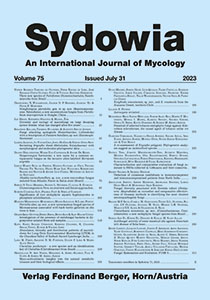
Abundance, diversity and distribution patterns of macrolichens for Long-Term Environmental Monitoring (LTEM) in the Chaudans Valley of Kailash Sacred Landscape, India K. Bisht, S. Upadhyay, K. Chandra, K. Chandra Sekar, V. Kumar & Y. Joshi Sydowia 75: 129-138 Published online on January 31, 2023 Realizing the importance of long-term monitoring for the assessment of the environmental status of the Kailash Sacred Landscape (KSL), an attempt has been made through assessing the abundance, diversity and distribution patterns of macrolichens in the Chaudans Valley. Since lichens are considered as the indicators of forest health, it is reliable to study their abundance, diversity and distribution patterns in a landscape for analyzing its environmental status. Macrolichens were studied in eight 20 × 20 m stratified random quadrats within the altitude ranging from 2400–4000 m. The study revealed the occurrence of 2157 colonies of macrolichens represented by 14 families, 30 genera and 60 species. Woody component (bark of trees and fallen twigs) was best for the macrolichen colonization in the study area supporting 1324 colonies followed by rock (574) and soil (259). Umbilicaria indica was the most abundant species confined to rocks. Peltigera polydactylon showed a broad range of distribution (2484–4071 m) due to its presence in all eight plots. Statistically, the relationship of altitude with species richness, number of genera and number of colonies was significant. With increasing altitude the species richness of macrolichen in Chaudans Valley was decreasing. Due to the diverse physiographic features of the landscape such a study further needs to be done in different regions preferably in other valleys and watersheds to find out the environmental status of the whole landscape. Due to the very slow growth rates of lichens it is recommended to monitor the same area for a period of about ten years for obtaining realistic results and draw inferences about changes during this time span to predict the future scenario. The present paper provides baseline data regarding the abundance, diversity and distribution patterns of macrolichens in the Chaudans Valley that can be monitored for long time periods to detect the changes over time. KSL is of great religious significance. The world famous Mt. Kailash and Manasarovara Lake are the main points of spiritual and sacred values of this landscape due to which thousands of people visit this region every year from different parts of the world. Chhota Kailash and Om Parwat are also of great religious significance in KSL. There is no doubt that KSL is spiritually sacred but its environmental sacredness is also of great importance and there is an urgent need of carrying out studies through which the environmental status of the region can be understood. The bioindicator and biomonitor roles of lichens can be helpful here. If its environmental sacredness declines, sooner or later its spiritual sacredness will also be disappeared. So, there is an urgent need to carry out such studies on the environmental status of the region and to take the necessary steps to protect its environmental sacredness. Keywords: lichens, Hindu Kush Himalaya, bioindication, biomonitoring. |
 |